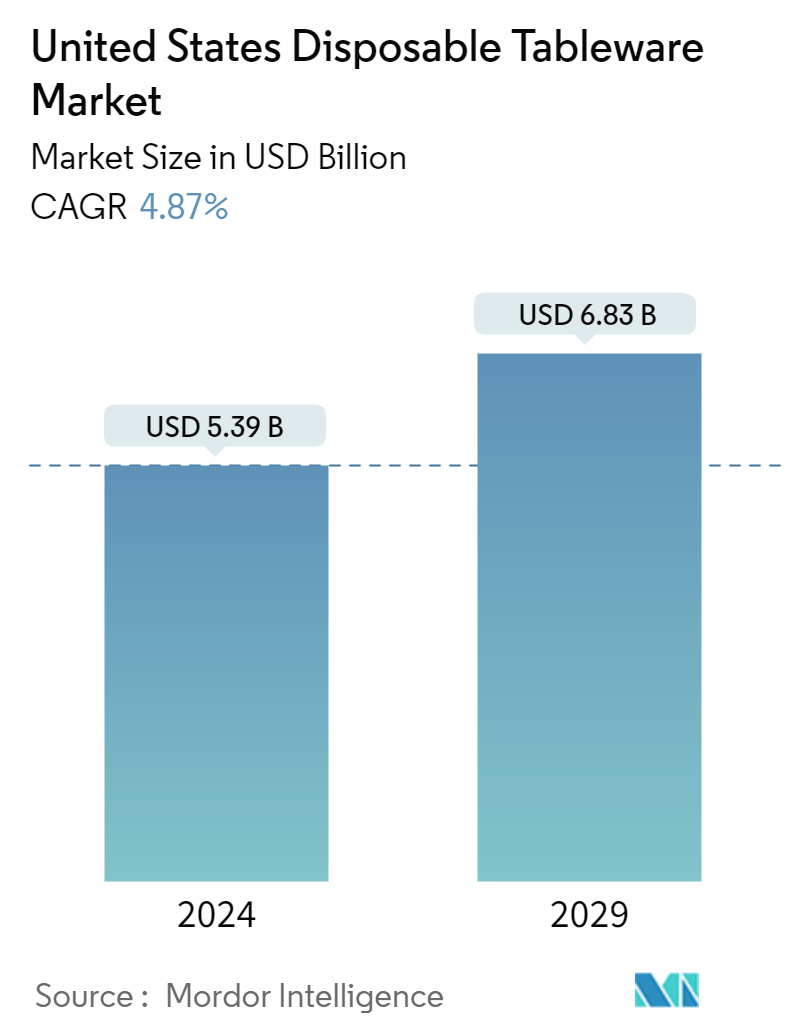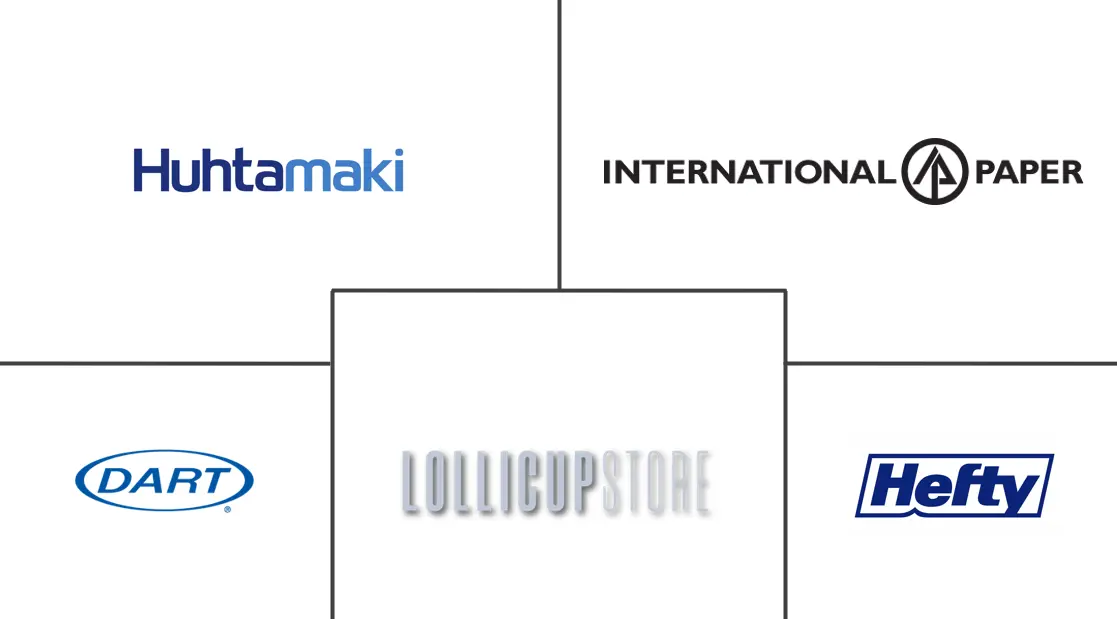Market Size of United States Disposable Tableware Industry

| Study Period | 2020 - 2029 |
| Base Year For Estimation | 2023 |
| Market Size (2024) | USD 5.39 Billion |
| Market Size (2029) | USD 6.83 Billion |
| CAGR (2024 - 2029) | 4.87 % |
| Market Concentration | Low |
Major Players
*Disclaimer: Major Players sorted in no particular order |
United States Disposable Tableware Market Analysis
The United States Disposable Tableware Market size is estimated at USD 5.39 billion in 2024, and is expected to reach USD 6.83 billion by 2029, growing at a CAGR of 4.87% during the forecast period (2024-2029).
Robust growth characterizes the US disposable tableware market, fueled mainly by the demand for disposable cups and plates. The key factors driving the market include the convenience offered by tableware, time-saving benefits, and the surge in popularity of online food delivery services. However, the market grapples with challenges, notably environmental concerns and a burgeoning demand for sustainable alternatives.
The rise of competition from reusable and eco-friendly tableware is reshaping the market dynamics, pushing manufacturers to innovate and align with evolving consumer preferences. Heightened global health consciousness is further fueling the adoption of disposable tableware. Manufacturing firms are pioneering new technologies to capture a larger market share and attract consumers to eco-friendly options. These disposable products are 100% biodegradable, providing a health-conscious and convenient solution for food packaging and consumption.
United States Disposable Tableware Industry Segmentation
Disposable tableware includes eating and drinking utensils made of paper and/or plastic that are disposed of after initial use. The report aims to provide a detailed analysis of the US disposable tableware market. It focuses on market dynamics and technological trends. The analysis encompasses key players and the competitive landscape of the market studied.
The US disposable tableware market is segmented by application type (commercial and residential), product type (disposable cups, disposable plates, disposable silverware, disposable bowls, and other product types), and distribution channel (hypermarkets and supermarkets, convenience stores, online, and other distribution channels). The report offers market sizes and forecasts in terms of value (USD) for all the above segments.
| By Application | |
| Commercial | |
| Residential |
| By Product Type | |
| Disposable Plates | |
| Disposable Cups | |
| Disposable Silverware | |
| Disposable Bowls | |
| Other Product Types |
| By Distribution Channel | |
| Hypermarkets and Supermarkets | |
| Convenience Stores | |
| Online | |
| Other Distribution Channels |
United States Disposable Tableware Market Size Summary
The United States disposable tableware market is experiencing significant growth, driven by evolving consumer preferences and industry innovations. The demand for disposable tableware surged during the COVID-19 pandemic, largely due to the increased reliance on online food delivery services. This shift was accompanied by a heightened awareness of health and hygiene, prompting consumers to opt for disposable plates and cups to minimize the risk of infection. The market is further bolstered by the foodservice industry's expansion, with food delivery apps seeing substantial revenue growth, which in turn fuels the demand for disposable tableware. The rise in fast-food consumption and on-the-go meal preferences, particularly among millennials, is also contributing to the market's upward trajectory.
Commercial establishments such as hotels and restaurants play a pivotal role in driving the disposable tableware market, as busy lifestyles lead more consumers to dine out rather than cook at home. This trend, coupled with factors like increasing disposable income, urbanization, and product innovations, is propelling the market forward. The competitive landscape is characterized by the presence of major players like Huhtamaki, DART, DIXIE, International Paper, and Hefty, who dominate the market share. Recent developments, such as the launch of eco-friendly products and strategic mergers, highlight the industry's focus on sustainability and quality enhancement. These dynamics underscore the market's potential for continued growth and adaptation to consumer and environmental demands.
United States Disposable Tableware Market Size - Table of Contents
-
1. MARKET DYNAMICS AND INSIGHTS
-
1.1 Market Overview
-
1.2 Market Dynamics
-
1.2.1 Market Drivers
-
1.2.1.1 Increasing Demand for Hygienic Dining Solutions
-
1.2.1.2 Increasing Preference for Convenience and Time-Saving Solutions
-
-
1.2.2 Market Restraints
-
1.2.2.1 Rising Competition from Sustainable and Reusable Alternatives
-
-
1.2.3 Market Opportunities
-
1.2.3.1 Growing Demand for Eco-friendly Alternatives
-
-
1.2.4 Value Chain / Supply Chain Analysis
-
1.2.5 Porter's Five Forces Analysis
-
1.2.5.1 Threat of New Entrants
-
1.2.5.2 Bargaining Power of Buyers/Consumers
-
1.2.5.3 Bargaining Power of Suppliers
-
1.2.5.4 Threat of Substitute Products
-
1.2.5.5 Intensity of Competitive Rivalry
-
-
1.2.6 Insights on Technological Developments in the Sector
-
1.2.7 Insights on Government Regulations in the Market
-
1.2.8 Impact of COVID-19 on the Disposable Tableware Industry
-
-
-
2. MARKET SEGMENTATION
-
2.1 By Application
-
2.1.1 Commercial
-
2.1.2 Residential
-
-
2.2 By Product Type
-
2.2.1 Disposable Plates
-
2.2.2 Disposable Cups
-
2.2.3 Disposable Silverware
-
2.2.4 Disposable Bowls
-
2.2.5 Other Product Types
-
-
2.3 By Distribution Channel
-
2.3.1 Hypermarkets and Supermarkets
-
2.3.2 Convenience Stores
-
2.3.3 Online
-
2.3.4 Other Distribution Channels
-
-
United States Disposable Tableware Market Size FAQs
How big is the United States Disposable Tableware Market?
The United States Disposable Tableware Market size is expected to reach USD 5.39 billion in 2024 and grow at a CAGR of 4.87% to reach USD 6.83 billion by 2029.
What is the current United States Disposable Tableware Market size?
In 2024, the United States Disposable Tableware Market size is expected to reach USD 5.39 billion.

